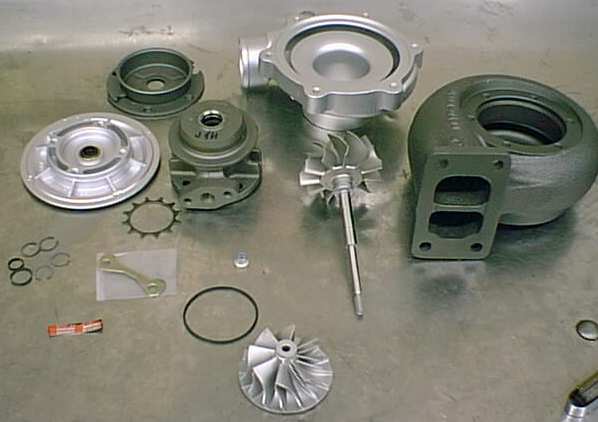Simply, a turbocharger takes exhaust energy and uses it to spin a turbine,
which in turn spins a *compressor* turbine, forcing more air into the engine.
First off, I feel kind of silly buying 3" exhaust after learning the
following thing: ALL of the exhaust that one cylinder bank produces has
to go through the exhaust side of the turbocharger. This is a hole approximately
half-dollar sized, with a FAN in the middle. Talk about back pressure.

In this picture, the snail looking part all the way on the right is
the exhaust section. All the exhaust goes through there.
Now, back to the picture. Top, just right of center; that's the compressor
housing. The way that works is it pulls air in through the round center
hole, and the air is accelerated by the compressor fan. Now you can KIND
OF see where the air goes. It moves outward radially from the center, across
the wide flat area and into the crack around the edges. It's possible to
see by the tube where the air will emerge (11:00 on the piece), that is
where the inside of the casing has the most volume, and if you go around
clockwise looking in the crack, the volume is less and less. On a good
turbo, this increasing volume (in the direction of air movement) is carefully
built in to match the amount of air expected to be pumped.
Some 'cheap' turbo-upgrade jobs (JW wouldn't name any company names)
are just that, due to the fact that often they core out the center hole
to allow more airflow and to allow for a bigger compressor fan inside the
stock housing. This doesn't work for two reasons:
-
See the wide flat area? That is necessary, because as the air moves outward
it slows down, thus increasing pressure; so if you bore out the center
for a bigger fan, then there's less of that flat area to slow the air and
therefore, less pressure than that size fan could give inside a proper
housing.
-
A bigger fan inside the stock housing will still push more air, but the
tunnel that is carefully engineered for a stock fan will not have enough
volume for the larger fan. Therefore, air will back up inside the turbo.
All JWT turbo rebuilds/upgrades have larger compressor housings
that match the larger compressor fan.
A good turbo upgrade-rebuild job will provide a larger compressor fan
as well as a larger housing for it; usually with a correspondingly larger
(as I will now coin it) air decelleration plate; as well as a larger volume
tunnel around the edges.
On the exhaust side, a much larger compressor fan will result in more
airflow and therefore more exhaust; so a larger exhaust housing and fan
is also frequently
installed.
Finally, I had for some time thought that the wastegate vented excess
boost from the system (not unlike a BOV); however I discovered within seconds
of looking at a turbo that it actually vents excess exhaust so that the
turbo doesn't continue to accelerate when the desired boost level has been
reached.
JaimeZX


